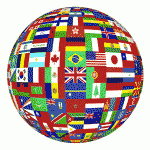The world’s 10 most influential languages
 Source: andaman.org
Source: andaman.org
In the 1992, language magazine Language Today had a feature on the world’s 10 most influential languages, written and researched by George Weber. This article was thoroughly researched (Weber spent 5 years compiling the data before writing up the article itself), and uses several surprisingly simple criteria to determine just how influential any given language is, awarding languages points for each of the following categories:
1. Number of primary speakers: max. 4 points
2. Number of secondary speakers: max. 6 points
5. Economic power of countries using the language: max. 8 points
4. Number of major areas of human acitivity in which the language is important: max. 8 points
3. Number and population of countries using the language: max. 7 points
6. Socio-literary prestige of the language: max. 4 points (plus an additional point for being an official UN language)
It is perhaps unsurprising that English, French and Spanish dominated the list, with Russian, Arabic and Chinese following behind.
It cannot be stressed enough that it is not inherent superiority, not linguistic but historical factors that have put English, French and Spanish where they are now.
Whatever the historical factors that have pushed English into the top position, they are still at work and look like continuing.
It should be a sobering thought, however, to any triumphalist impulse that in 100 AD Latin looked set to dominate its slice of the world forever.
It is also interesting to note that 1000 years ago, French was the language that would have topped the list, but the rise of English has brought its dominance to an end. It really makes you wonder what people will be speaking in another 1000 years!
However, using only certain criteria yielded very different results. For example, going only by number of native speakers, Chinese is spoken by 20.7% of the world’s population – the next in line is English with only 6.2%. However, it should be noticed that Chinese has many different dialects, some of which could almost be considered languages in their own right.
The data can be further broken down, and provides some fascinating results. Take a look at the article and see the results for yourself!
